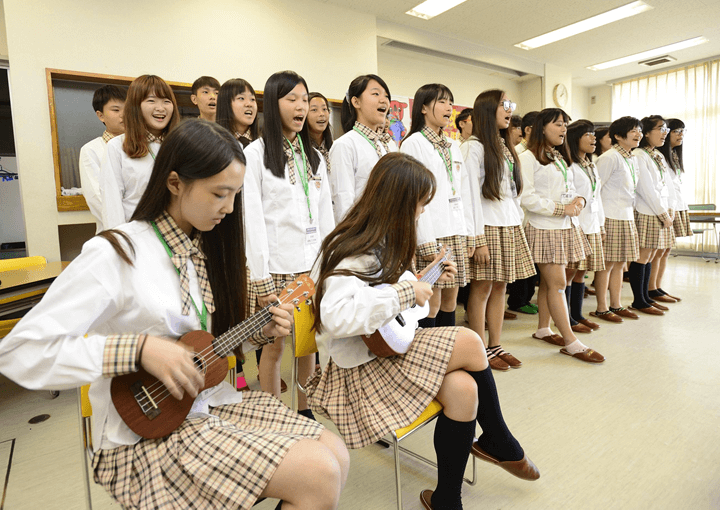
School Profile
| School Name | Hsinchu Hsiang Shan Municipal High School |
|---|---|
| Location | Taiwan (Asia) |

Outline
| Time of Travel | October 2016 |
|---|---|
| Age of Participating Students | 16-18 years old |
| Number of Participants |
40 people 32 students, 7 tour leaders and 1 tour conductor |
| Host School (School Exchange) | Chiba Prefecture Awa Takushin High School (Chiba Prefecture) |
Host School (School Exchange)
location_cityHost School
| Location | Chiba |
|---|---|
| School Name | Chiba Prefecture Awa Takushin High School |
location_cityProgram
| 10:00 |
Greetings  |
|---|---|
| 10:20 |
School Campus Tour  |
| 11:00 |
Class Exchange
  |
| 12:15 |
Lunch   |
| 13:00 |
Welcome Party
 |
| 13:15 |
Exchange meeting
 |
| 14:00 |
Send-off  |
Reviews
location_cityFaculty feedback and advice for success

Japan offers reliable planning, and distinct regional cultures. The high moral consciousness of Japanese students serves as a model for Taiwanese students. Through international exchanges, I hope students can cultivate national identities!
Our school has always been interested in international educational travel.
This is our fifth educational travel to Japan. I think Japan does a remarkable job in public relations. Japan is worth visiting because of their precise and reliable planning, and distinct regional cultures. This is the reason why we chose to visit Japan instead of other neighboring countries.
I have visited Tokyo, Osaka, Nara, and Hiroshima.
This time, we chose Chiba prefecture because it is not so highly urbanized, and the geographical situation is similar to that of Hsinchu. Also, we chose Awatakushin High School because the school system is similar to ours: they offer general and specialized courses. The most important thing is that they cherish their connections with other junior high schools, which we regard as a model. This school is famous for the principal’s active efforts towards educational travel promotion.
Japanese schools are wonderful. I am aware that Japan is promoting moral education. Although the process is the same as that in Taiwan, Japan has done a better job. Students not only possess high moral consciousness, but they are also able to focus on their studies. In this regard, Japan is a model for Taiwan to follow.
Now, we are working on promoting the characteristics of regional areas of Taiwan. Therefore, I would like to visit local cities other than Tokyo. I also want the students to understand the importance of international competitiveness. Through international exchanges, I hope they can cultivate their own national identities.
location_city Reviews from Students

Spending time with elderly ladies. Praying at shrines. Writing calligraphy at school. There are many opportunities to learn and experience Japanese history and traditional culture.
The most memorable part of the educational trip to Japan was the homestay experience. I did the dishes and laid out futons together with an elderly lady at a farmhouse. Her homemade breakfast was so delicious.
I also ate a homemade rice cake (omochi) at dinner. Though we also have rice cakes in Taiwan, they are rarely homemade, and usually contain artificial ingredients. In Japan, rice cakes and bean pastes inside are homemade.
During the school exchange, I was very impressed by that, unlike in Taiwan, the school buildings were very clean, and Japanese students greeted me warmly.
I chose calligraphy for classroom experience. In Taiwan, we are required to write a specific Chinese poem, while in Japan, I was able to write anything I wanted, and I enjoyed it a lot.
It was not my first time coming to Japan, so I did not face any difficulties during my stay here. Ever since I was a child, I have always felt that Japanese towns were beautiful, and that the people here were very polite.
If my juniors are to visit Japan next year, I will recommend them to visit a shrine. I myself went to a shrine yesterday. Not only was I able to take a look at the shrine, but I was also able to learn manners of praying, and experience traditional tea ceremony in kimono.
The homestay, school exchange, and shrine-visiting experiences during the educational travel have become the precious moments in my life.

I was impressed by Japanese’s politeness and cleanness at schools and temples. I was glad to do real practices than just to learn theories.
The most memorable part of the educational travel in Japan was sleeping on tatami mats during my homestay. All the dishes the host family made were delicious, and I found konnyaku (Konjac) especially delicious. The taste was superb, with its texture different from that in Taiwan.
I also enjoyed hiking and seeing Buddha statues. Although hiking was tough, it was worth it because of the beautiful scenery. Japanese temples were more well-organized and cleaner than Taiwanese temples.
During the school exchange, I was impressed that everyone was so polite and the buildings were clean. Everyone was very kind and offered me help before I asked. However, I was surprised by how small the meals for Japanese students were.
During the classroom experience, I made corsages in a gardening class. Though I specialized in design, I wish I could have done better. In Taiwan classes are focused on lectures and theory, but Japanese classes were more orientated towards practical skills and allowed you to actually experience making things, so I enjoyed them.
The most inconvenient things I found staying in Japan were that a card was required to insert in the television, and there were few channels to watch. Also, I did not know that chopsticks were not allowed to be placed on a plate during a meal.
This trip to Japan was a good experience because I was able to experience homestay, hiking, and practical lessons, and to gain a better understanding of Japanese etiquette, organization, and living environment.
Highlights













